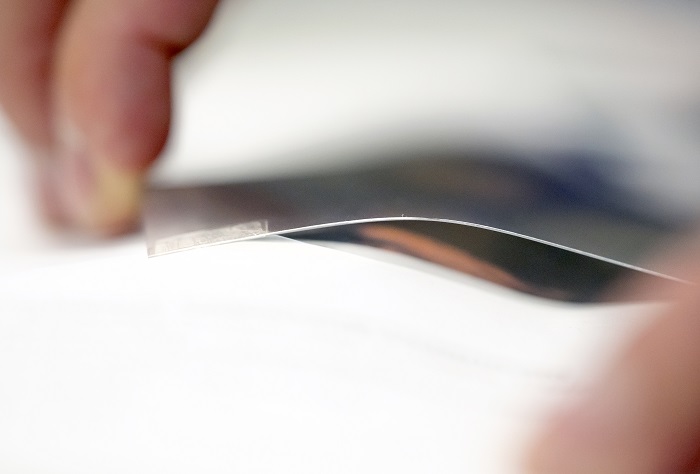By Gina Roos, editor-in-chief
Researchers at UC Berkeley College of Engineering recently announced that they developed a piezoelectret-based device that is a sensor and actuator. The device vibrates as feedback, similar to how it works in smartphones. But this technology is also very flexible, lending itself to be integrated into clothing and other wearable technologies.
Researchers believe that this technology could significantly improve the user experience in augmented and virtual reality (AR/VR) applications, changing the way they see and hear. In fact, they believe that it could provide touch feeling in immersive virtual experiences in the future.
In addition, the vibrations generated by the actuator can be customized, which could be used to help people with visual or hearing impairments communicate via vibrations.

The sensor-actuator patch is about 150 µm thick, similar to the diameter of a human hair. (Image: Adam Lau, UC Berkeley College of Engineering)
“There are many applications for this technology that can sense motion and give haptic feedback,” said Liwei Lin, mechanical engineering professor and co-director of the Berkeley Sensor & Actuator Center (BSAC), in a press release. He is also one of the lead authors of the technical paper published in ACS Nano. “One application is AR/VR. Right now, if you are playing a game and hitting a wall, you only hear a sound. With our device, the sensor can detect if you are going to hit something, and the actuator can vibrate to simulate a physical impact.”

The ability to achieve both sensor and actuator functions is based on an innovative sandwich structure that harnesses piezoelectricity, said Juwen Zhong. (Image: Adam Lau, UC Berkeley College of Engineering)
Juwen Zhong, a postdoctoral researcher at BSAC and a lead author on the paper said, the that device is 150 µm thick, which is similar to the diameter of a human hair. “Its flexibility and its ability to achieve both sensor and actuator functions is based on an innovative sandwich structure that harnesses piezoelectricity.”
The outside layers of the sandwich structure consist of fluorinated ethylene propylene elect films, while the Ecoflex spacer middle layer is coated with gold aluminum electrodes on top and aluminum electrodes on the bottom.
The sensor function can generate electrical outputs without a power supply, which can turn on the actuator via electrostatic force to generate the vibrations that can be felt by human skin. Today, the actuating mode can generate up to 20 meganewtons (MN), similar to a cellphone. It can also sense objects as light as a dandelion seed.
Zhong said that this device outperforms popular piezoelectric materials, showing a high piezoelectric coefficient and low driving voltage. This is key to improving the sensor’s sensitivity and the amount of electricity needed to power the actuator, he said.
The prototype has only nine pixels, but researchers would like to add more “piezoelectric pixels” that would enable vibrations that mimic different textures. They also plan to work on lowering the voltage required to power the device.
Advertisement
Learn more about Electronic Products Magazine





